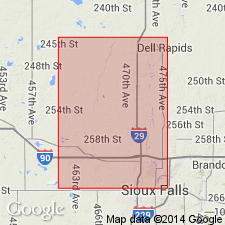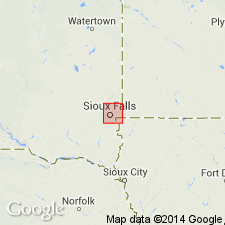
- Usage in publication:
-
- Corson Diabase
- Modifications:
-
- Overview
- AAPG geologic province:
-
- Lake Superior region
Summary:
Is mostly quartz and muscovite? with feldspar and hematite. Fresh diabase is black with a greenish-yellow tinge. Has moderately to severely altered plagioclase and relatively unaltered olivine and augite. Where deeply weathered diabase forms a red, hard, earthy mass; chemical changes have taken place. Minimum date of 1.1 b.y. report on apatite from Corson. Diabase too intensely weathered for a Rb-Sr date. The Sioux Falls area is in southeastern Minnehaha Co, SD in Lake Superior region.
Source: GNU records (USGS DDS-6; Denver GNULEX).

- Usage in publication:
-
- Corson Diabase
- Modifications:
-
- Revised
- AAPG geologic province:
-
- Lake Superior region
Summary:
Corson diabase revised in that it is exposed beneath the Split Rock Creek Formation (named) in Minnehaha Co, SD in Lake Superior region. Is intrusive into the Sioux Quartzite. Cross sections. Of Precambrian age.
Source: GNU records (USGS DDS-6; Denver GNULEX).
For more information, please contact Nancy Stamm, Geologic Names Committee Secretary.
Asterisk (*) indicates published by U.S. Geological Survey authors.
"No current usage" (†) implies that a name has been abandoned or has fallen into disuse. Former usage and, if known, replacement name given in parentheses ( ).
Slash (/) indicates name conflicts with nomenclatural guidelines (CSN, 1933; ACSN, 1961, 1970; NACSN, 1983, 2005, 2021). May be explained within brackets ([ ]).

